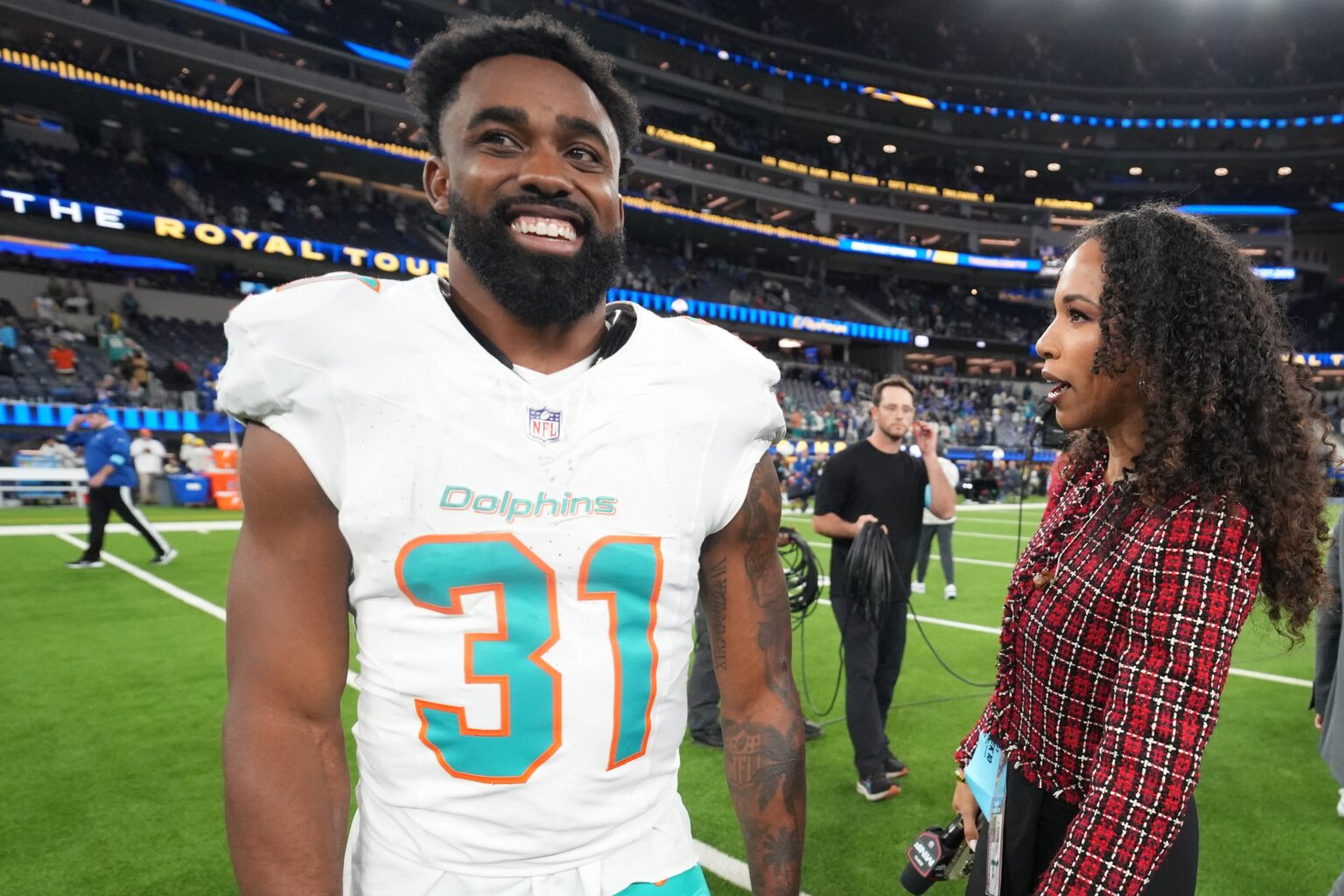Multiple Players Released from the Miami Dolphins: A Strategic Shift Toward Rebuilding
The Miami Dolphins are making significant moves this offseason as they prepare for a future of sustained success. In a series of surprising decisions, the team has released several key players from their roster in order to clear salary cap space and shift toward a rebuild. These moves come as part of a broader strategy to build a more sustainable and competitive team for the future, while also allowing the Dolphins to focus on young talent and financial flexibility.
The decision to part ways with veterans, many of whom played important roles in Miami’s recent seasons, signals a clear commitment to long-term planning. As the Dolphins’ management, led by general manager Chris Grier and head coach Mike McDaniel, looks to establish a new identity for the team, these moves could shape the future of the franchise.
Players Released by the Dolphins
Several notable players were let go during this cap-clearing exercise, each move shedding light on the team’s evolving strategy. Let’s break down the most impactful departures.
1. Byron Jones – Cornerback
One of the most significant moves came when the Dolphins released veteran cornerback Byron Jones. Signed in 2020 to a lucrative deal, Jones was expected to be a cornerstone of Miami’s defense, providing a shutdown presence opposite fellow cornerback Xavien Howard. However, injuries limited his effectiveness, and he struggled to stay on the field consistently.
In addition to his physical decline, Jones’ large cap hit – over $13 million for 2025 – became a burden on a team that needs to free up space for other acquisitions. His release provides the Dolphins with much-needed cap space while also creating opportunities for younger defensive backs to step into more prominent roles. With Jones now off the books, the Dolphins can invest in their defense in more cost-effective ways, either by bringing in younger talent or signing players who better fit the team’s long-term needs.
2. Raheem Mostert – Running Back
Another player who found himself released this offseason was running back Raheem Mostert. A speedy and explosive weapon, Mostert was one of the key contributors to Miami’s offense, providing big plays out of the backfield. However, his injury history and the Dolphins’ focus on creating a younger, faster roster made his departure inevitable.
Mostert had a solid year in 2024, but Miami’s shift to a more sustainable roster means prioritizing the development of younger players. Moving on from Mostert saves the Dolphins around $5 million in cap space, which can now be reallocated toward other areas of need. With young talents like De’Von Achane expected to take on a larger role in the running game, the Dolphins are looking to maximize the potential of their backfield without committing significant resources to a veteran running back with an injury-prone history.
3. Mike Gesicki – Tight End
Perhaps the most unexpected release was that of tight end Mike Gesicki, a player who had been one of Miami’s most reliable offensive weapons in recent years. Gesicki, known for his ability to stretch the field and create mismatches in the passing game, was traded to another team in exchange for draft capital. While his departure may surprise some fans, it is a strategic decision that reflects the Dolphins’ evolving offensive philosophy.
Under head coach Mike McDaniel, Miami has looked to create a more dynamic and versatile offensive system. Gesicki, while talented, didn’t always fit perfectly into that scheme. His inability to contribute significantly as a blocker and his inconsistent production as a receiver led the team to part ways with him. By trading Gesicki, the Dolphins are not only saving cap space but also making room for a new generation of tight ends who can contribute in a variety of ways. The move also gave Miami additional draft picks, which can be used to strengthen other areas of the roster.
4. Emmanuel Ogbah – Defensive End
In a move that will surely turn heads, Miami also made the decision to release defensive end Emmanuel Ogbah. Ogbah had been one of the most consistent pass-rushers for the Dolphins over the past few seasons, but with his cap hit set to increase, it was clear that the team needed to make a change.
Ogbah’s release, which frees up nearly $10 million in cap space, highlights the Dolphins’ prioritization of financial flexibility in their rebuild. While Ogbah provided solid pressure on opposing quarterbacks, the team is now looking to invest in younger pass rushers who can provide similar production at a more cost-effective rate. Miami will likely target pass-rushing talent in the draft or through free agency, as the team works to reload its defense with young, impactful players.
5. Teddy Bridgewater – Quarterback
Veteran quarterback Teddy Bridgewater was another notable departure from the Dolphins’ roster. Bridgewater had served as the backup to Tua Tagovailoa in 2024, but with the team looking to trim salary and improve overall depth, Bridgewater’s release seemed like a necessary move. Miami is expected to bring in a cheaper backup quarterback to serve as Tua’s insurance, but the priority will be ensuring that the salary cap remains clear for the Dolphins’ future plans.
Bridgewater’s release doesn’t necessarily signal a lack of faith in Tua, but it does reflect the Dolphins’ intention to maximize their financial flexibility in other areas. A cheaper backup quarterback will allow the team to invest in more pressing needs such as the offensive line and defense.
The Dolphins’ Rebuilding Strategy: Financial Flexibility and Youth
The common thread running through these moves is financial flexibility. Miami is making it clear that they’re willing to part ways with key veterans if it means freeing up space to pursue younger talent or future draft picks. As the team pivots toward a longer-term rebuilding strategy, it’s likely that we’ll see more cap-clearing moves in the coming weeks.
By releasing these players, the Dolphins are setting themselves up for a future that is focused on youth, development, and flexibility. With the salary cap cleared, Miami is in a prime position to make moves in free agency and use their ample draft capital to address areas of need. The Dolphins have been active in the draft in recent years, and this season will be no different. The team is expected to target key positions such as the offensive line, defensive line, and secondary, where they can add young talent that will help them compete in the long run.
Miami’s rebuild is also about improving their depth. While they have key players like quarterback Tua Tagovailoa, wide receiver Tyreek Hill, and defensive lineman Christian Wilkins to build around, the team is looking to surround those stars with a solid supporting cast. Through smart free-agent signings, shrewd draft picks, and development of young players, the Dolphins aim to create a roster that can compete for years to come.
Looking Ahead: What’s Next for Miami?
With the salary cap space now cleared, the Dolphins will look to make additional moves to shore up their roster. The front office will likely focus on a few key areas:
- Offensive Line: The Dolphins will likely target improvements along the offensive line, an area where they have struggled in recent seasons. Tua Tagovailoa’s health is a key priority, and improving the protection around him will be critical.
- Defensive Line and Secondary: Miami’s defense needs further investment, particularly in the pass rush and secondary. The team will target both in the draft and free agency to solidify these positions and build a more complete defense.
- Wide Receiver Depth: While Tyreek Hill and Jaylen Waddle are both elite options at wide receiver, the Dolphins could look to add depth behind them, especially a receiver who can provide a reliable option in the slot or as a deep threat.
- Special Teams: The Dolphins will also look to improve their special teams unit, an area that can often make the difference in close games.



